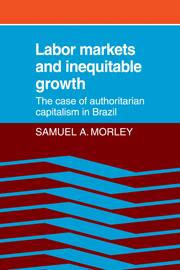Book contents
- Frontmatter
- Contents
- List of tables and figures
- Preface
- Part I Growth, employment creation, and inequality in Brazil
- Part II The effect of supply and demand on labor markets during rapid economic growth
- 6 Migration and the modernization of the agricultural labor force
- 7 The absorption of migrants into the urban economy
- 8 Trends and theories of the wage differential during economic growth
- 9 The market for skilled labor
- 10 Agriculture, wage policy, and the wages of unskilled labor
- 11 Additional perspectives on inequitable growth in Brazil
- 12 Conclusions
- Data appendix
- Bibliography
- Index
7 - The absorption of migrants into the urban economy
Published online by Cambridge University Press: 07 October 2011
- Frontmatter
- Contents
- List of tables and figures
- Preface
- Part I Growth, employment creation, and inequality in Brazil
- Part II The effect of supply and demand on labor markets during rapid economic growth
- 6 Migration and the modernization of the agricultural labor force
- 7 The absorption of migrants into the urban economy
- 8 Trends and theories of the wage differential during economic growth
- 9 The market for skilled labor
- 10 Agriculture, wage policy, and the wages of unskilled labor
- 11 Additional perspectives on inequitable growth in Brazil
- 12 Conclusions
- Data appendix
- Bibliography
- Index
Summary
In this chapter we reach the heart of the labor modernization process, the absorption of rural migrants by the urban labor market. We will look at the personal and occupational characteristics of the migrant and nonmigrant urban population, and then investigate the performance of migrants in the urban labor market. What are the port-of-entry jobs for migrants? How well do migrants do over time? How do their occupations and income compare with those of nonmigrants? Are there regional differences, or differences between the patterns observable in metropolitan areas and smaller cities? Finally, we will try to characterize the urban labor market in terms of the formal–informal or modern–traditional dichotomy that has become popular in recent years.
The characteristics and occupations of urban migrants
There are three particularly noteworthy characteristics of urban migrants: They have an unexpectedly high educational level; they tend to be young; and a high proportion of them are women (see Table 7.1). The table clearly shows that the bulk of migrants were in the most active years of their working lives. One-third were between the ages of 15 and 29, and an additional fourth between 30 and 44. Compared with the native population, they had relatively few children. Since, as we shall see, participation rates were higher for migrants than for nonmigrants of the same age group, we can conclude that migration was related to work. People migrated to jobs at an age when they could work. There was also a small but significant group who migrated and retired.
There was a marked predominance of women in the 15 to 29- year-old migrant group, particularly in the North and Northeast.
- Type
- Chapter
- Information
- Labor Markets and Inequitable GrowthThe Case of Authoritarian Capitalism in Brazil, pp. 141 - 180Publisher: Cambridge University PressPrint publication year: 1983



